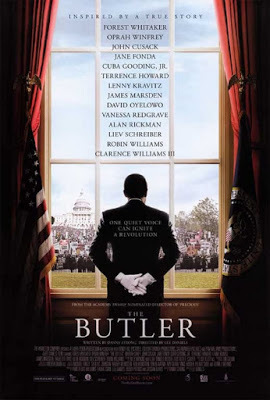Beverly Gray's Blog: Beverly in Movieland, page 53
September 22, 2020
Mad About (and sometimes Mad At) “Mad Men”
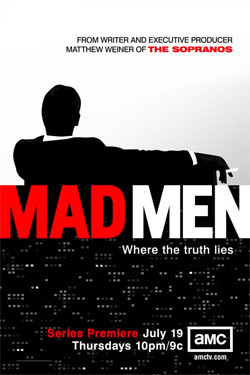
As a passionate movie fan, I tend to ignore television. Yes, growing up I had my favorites. But in recent decades I’d movie-go for pleasure, and use my TV set only for special events like the Oscars and the Olympics. Which means I missed a lot of the famous series that everyone else was discussing, like The Sopranos and Breaking Bad.
What a difference a year makes! Now, quarantining at home, I look to my nightly TV time as a chance to glance back at shows I’d missed. I can now converse knowledgeably about The Crown, The Good Place, The Unbreakable Kimmy Schmidt. And it’s been a pleasure to dig into the terrific series that took home all the Emmys a decade ago. While Jimmy Kimmel was distributing Emmys over the weekend via messengers in tuxedo/HAZMAT combos, I was polishing off the adventures of Don Draper and his colleagues in the wonderful world of advertising. Believe me, it was quite a ride.
Movies, of course, must establish and “sell” their characters in about two hours’ time. The leading roles should ideally be complex, but there’s a need for shorthand. We simply don’t have time to explore every facet of a character’s existence. In a long-running series, though, a guy like Don Draper can go in all sorts of directions (as we ourselves tend to do in real life). Don (played by the astonishingly handsome and square-jawed Jon Hamm) is larger than life in his professional world. He’s a brilliant ad man, respected by one and all for his creativity, integrity, and business smarts. But, over seven seasons, he’s also proven himself to be at times petty, cruel, and narcissistic. He’s capable of great love, especially for his children, but he’s also a serial philanderer. He’s also both rock solid and (occasionally) a quivering mass of Jello, someone who’s never gotten over a grotesque childhood and a deception (while serving in the military in Korea) that proves to have long-term consequences for his psyche.
Don isn’t the only rich character on Mad Men. The lusty “silver fox,” Roger Sterling (John Slattery) is a total heel when it comes to the women in his life, but he can also be loyal and sweet in a surprisingly childlike way. Vincent Kartheiser’s Pete Campbell is a genuine snake in the grass, but over time we also see him grow up and, perhaps, become a better man. But of course I’m especially rooting for the female characters, and this series set in the Sixties has a lot to say about women’s slow march toward professional advancement. The bodacious Joan (Christina Hendricks), she of the impossibly voluptuous figure, starts off as a kind of living blow-up doll but turns out to have a head as well as a body. And eager, ambitious Peggy Olson (break-out star Elisabeth Moss) is someone for whom we can root, even when she makes terrible choices.
I love the way characters evolve, shift in their alliances, and find new paths. Still, seven years is a long time for writers to keep coming up with ideas, and, as the series wears on, some of the incidents on-screen seem too wacky to be believed. Still, I adored the send-off given to the elder statesman of the group, played by the once up-and-coming Robert Morse. This slightly mysterious Zen-like oldster dies in Season 7 while watching Neil Armstrong walk on the moon. An episode or so later, he reappears to Don in a vaudeville-type routine, crooning “The Best Things in Life Are Free.” It’s a message that perhaps Don finally takes to heart.
 Robert Morse's finale: "The Best Things in Life Are Free"
Robert Morse's finale: "The Best Things in Life Are Free" September 18, 2020
Serving Time with Lee Daniels' "The Butler"
With the upcoming presidential election high on our minds right now, it's no surprise I got interested in watching a 2013 film that boasts a pretentious title: Lee Daniels' The Butler. Daniels had won acclaim for directing 2009's Oscar-winning Precious. As the rare Black director to cause a stir in Hollywood, he perhaps added his name to the title of this movie as a way of encouraging investors with deep pockets as well as strong social consciousness to get involved. In any case, the film managed to raise its $30 million budget by appeals to 41 producers and executive producers, all of whose names appear on the screen in the opening credit sequence. The Butler was eventually distributed by the Weinstein Company, long before Harvey's sexual predilections caused a once-great career to flame out. So it goes.
In any case, The Butler, adapted from a 2008 Washington Post article, borrows from the life of an African-American man, Eugene Allen, who served in the White House from 1952 to 1986. Starting with the administration of Dwight D. Eisenhower, he wore formal dress to serve meals and otherwise act as an impeccably groomed retainer. Under Ronald Reagan, he and his wife were honored guests at a state dinner, making him the first White House butler ever to be so honored. It's a good story---but Hollywood was not content to keep it simple, stupid.
In the film, the Oscar-winning Forest Whitaker plays Cecil Gaines, a version of Eugene Allen who also owes something to Forrest Gump. Everything happens to him. Beginning as a young sharecropper in a Southern cotton field, he sees his father shot dead by the evil white man who has just raped his mother. A semi-sympathetic Southern lady (Vanessa Redgrave, of all people) then takes him into the plantation house as a servant, teaching him genteel ways of bowing and scraping for his white betters. Eventually he grows up and moves on, marrying and fathering two sons. But so devoted is he to his White House obligations that his restless wife (Oprah Winfrey, nicely convincing) retreats into alcoholism and a dead-end affair. As for his sons, the younger -- a patriotic lad -- marches off to serve in Vietnam. (You just know he'll return in a casket.) By contrast, the collegiate elder son Louis (David Oyelowo) becomes enamored of the nascent Civil Rights Movement. After he's participated in sit-ins and landed in jail, his activist spirit moves him to join the Black Panthers.
Sometimes the playing off of a personal story against a public one is effective. For me the film's strongest moment comes as Louis and his fellow activists are manhandled by angry whites after trying to order food at a Louisville luncheonette. While they are being pelted with food and otherwise tormented, papa Cecil--resplendent in formal suit and white gloves--is helping to serve an elegant White House repast. Mostly, though, this race through late Twentieth Century history seems stilted: how much can we take of quick montages of the music, fads, and personalities of each era? And what's Princess Diana doing there, anyway?
The Butler is probably most notorious for what we might call its stunt casting. Various American presidents are represented on-screen by famous Hollywood actors, most of whom bear little resemblance to the actual men they're impersonating. Robin Williams as Eisenhower? John Cusack as Nixon? Liev Schreiber as LBJ? The mind boggles, especially with the casting of Alan Rickman as Ronald Reagan and none other than Jane Fonda as Nancy. When faces (and voices) this familiar are presented on-screen, shouldn't they seem convincing?
September 15, 2020
As You Wish Upon a Star (The Princess Bride Returns)
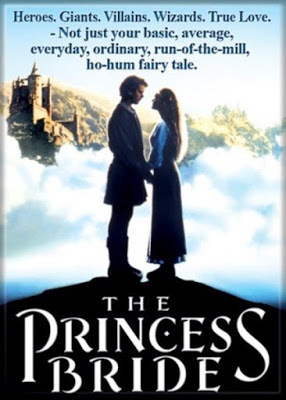 Over the weekend, when I sat down to watch The Princess Bride, I didn't realize I was part of a trend. Maybe it's a general desire for escapism at a time of national crisis. With the COVID-19 pandemic breathing down our necks and a crucial election roiling public emotions, we can all appreciate a quick trip to long-ago and faraway, especially when we're guaranteed an ending in which all of the good guys live happily ever after.
Over the weekend, when I sat down to watch The Princess Bride, I didn't realize I was part of a trend. Maybe it's a general desire for escapism at a time of national crisis. With the COVID-19 pandemic breathing down our necks and a crucial election roiling public emotions, we can all appreciate a quick trip to long-ago and faraway, especially when we're guaranteed an ending in which all of the good guys live happily ever after. When The Princess Bride -- directed by Rob Reiner and adapted by the great William Goldman from his own novel -- was released in 1987, it was no great shakes at the box-office. It took the new phenomenon of home video to vault the film into the ranks of classic cinema. Generations of children, watching The Princess Bride in their living rooms, took Westley, Buttercup, and all the rest into their hearts. This seems entirely apt, since the heroic tale is framed by the tender relationship between a grandfather (Peter Falk) and his young grandson (Fred Savage), and takes on the aspect of a story passed between the generations. The kid is sick in bed, and Grandpa tries to entertain him by sharing a favorite storybook. It's full of pirates and duels and betrayals and escapes (and not overmuch in the way of kissing scenes): what more could any boy want?
The film's beauty lies partly in the perfection of its casting choices: Cary Elwes as a dashing hero, Robin Wright as an ethereal but spunky leading lady, Chris Sarandon as the thoroughly rotten Prince Humperdinck, Christopher Guest as his evil (and digitally challenged) sidekick. Fan favorites include the oddball trio of shrewd little Vizzini (Wallace Shawn), hulking Fezzik (André the Giant), and the soulful swordsman Inigo Montoya (Mandy Patinkin), always on the track of his father's killer. Even screwier are Billy Crystal and Carol Kane, unrecognizable under heavy makeup as Miracle Max and his wife.
As befits a classic, The Princess Bride has become a part of our daily vocabulary. It's inconceivable (tee hee!) that a fan of the film wouldn't react to Inigo's oft-repeated "Hello. My name is Inigo Montoya. You killed my father; prepare to die!" And "As you wish," as a secret way of saying "I love you" has its charm. Today's Hollywood adores The Princess Bride so much that when actors had been stuck in quarantine for months, they all leapt at the idea of shooting, bit by bit, a "home movie" version, produced by Ivan Reitman to benefit the World Central Kitchen charity. It is notably for zany casting, for home-grown props (like Diego Luna fencing with an umbrella against Jack Black wielding a plastic Jedi sword), and for the final appearance of Carl Reiner as the Grandfather, saying "As you wish" to his son Rob (playing the Fred Savage role) just a few days before Carl's passing at the age of 98. Everyone from Tiffany Haddish to Hugh Jackman to Shaquille O'Neal gets into the act, sometimes switching roles in mid-scene.
And on September 12, members of the original cast reunited online for a reading of Goldman's original script. This too was a fundraiser, in which at least 100,000 fans tuned in to contribute toward the Biden campaign in the swing state of Wisconsin. Once the reading was done, a Q&A revealed lively political sentiments from those involved. Billy Crystal, for one,joked that his character, Miracle Max, had lost his place in the castle – despite his ability to raise the dead — because he wrote a book revealing that Prince Humperdinck “didn’t care about the plague.”
Here's a clip from Jason Reitman's "home-movie" version of the film
September 11, 2020
Making Noise About "The Quiet Man"
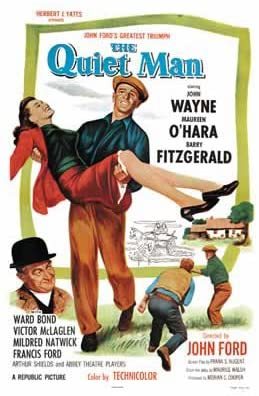
During this pandemic, I'll gladly watch anything that removes me from our current miserable circumstances. Which is why I decided to check out a film my late parents had adored. I mean The Quiet Man, the romantic romp from 1952, starring John Wayne and Maureen O'Hara in a courtship ritual full of both kisses and kicks, set in the imaginary Irish country town of Innisfree. The film, shot by John Ford on location in County Mayo, is peopled by members of the Ford stock company, including Victor McLaglen as a powerful local squire, Ward Bond as the community's priest, and Barry Fitzgerald as an imp of a factotum who makes sure that Innisfree doesn't deviate from age-old tradition.
My parents, hardly lovers of John Wayne, had no special feelings for Ford's classic American westerns. But they loved The Quiet Man for its breezy comic approach to the battle of the sexes. I think they were happy to see it as a fairytale with a happy ending. Not Irish themselves, they took in stride its depiction of the Auld Sod as a place rife with drinking, gambling, carousing, and the occasional donnybrook; they shrugged off the surprising moment when a local wife -- coming upon John Wayne dragging his stubborn new wife through the fields -- counsels, "Here's a fine stick to beat the lovely lady."
Though I thoroughly enjoyed Ford's expert filmmaking, I have found myself wondering how the Irish of today view the movie. The Internet of course uncovers a wealth of opinions. One contributor doesn't equivocate, calling The Quiet Man "a violent stereotypical travesty that has done our proud nation untold harm abroad." By contrast, a scholar named William C. Dowling has written at length as to how the film is less about cultural imperialism than the power of cultural myth. Labeling The Quiet Man as Ford's "struggle for artistic expression against the commercial imperatives of the Hollywood glamour empire," he puts it in the context of those rowdy Shakespearean comedies in which the spirit of Saturnalia ultimately binds a community together. (I should add that Dowling, a Rutgers professor emeritus, is New Hampshire-born, so maybe his opinion doesn't count.)
My friend and colleague Beth Phillips, a great lover of all things Irish, has sent me a quote from her mentor, Adrian Frazier, as published in his book, Hollywood Irish: "Ford's Irish movie is like a Christmas pudding made from an ancient recipe, stuffed with nuts and fruits and coins and candies of every description, then soaked in liquor." Her friend James Mullaney of County Mayo is slightly more positive, recognizing certain aspects of the film as true and saying that the film's characters, "like those on the American television show The Bevery Hillbillies, are exaggerated but, at the same time, recognisable--both to an Irish viewer and an international viewer. " As for poet Noel Duffy, he admits that his mother's generation generally liked the film, given the power of its stars and that fact that "it was pretty rare to see films based in Ireland back then." Today, however, "My strong sense is that my generation view The Quiet Man as the worst form of Paddy-whackery, but then the Irish [rebroadcast it] every St Patrick's Day so maybe your average punter might still like it. Anyone younger than me . . ., is probably not even aware of the film's existence."
Sure, there's something rather disturbing about a headstrong young wife essentially demanding to be dominated by her new mate. Still, in some ways SHE wins the battle And there's something quite lovely about that.
Deepest thanks to Beth Phillips, who ought to check out this movie for herself!
September 8, 2020
Chadwick Boseman Forever

It's hard to imagine not feeling sad about the passing of Chadwick Boseman, the talented and charismatic actor who has just died of colon cancer at age 43. He had so much living left to do, and so many indelible portrayals to give us. Boseman was, of course, the Marvel Universe's Black Panther, the noble and idealistic ruler of the imaginary African kingdom of Wakanda. This year he was the revered Stormin' Norm Holloway in the flashback sections of Spike Lee's Vietnam film, Da 5 Bloods. And we have yet to see his final performance, in the film version (now in post-production) of one of August Wilson's most dynamic plays, Ma Rainey's Black Bottom. With Oscar-winner Viola Davis in the title role, this should be a production worth checking out.
In his film career, which commenced in 2008, Boseman has specialized in playing historic figures, imbuing them with both humanity and flair. In 2013, he was Jackie Robinson in 42, conveying the challenges faced by the first Black man in Major League baseball. Two years later, he took on the mantle of James Brown in Get On Up. In 2017, by now a co-producer as well as a star, he portrayed Thurgood Marshall, in a film focusing on the 1940 case that brought him fame as an NAACP attorney, long before he broke the color barrier on the U.S. Supreme Court. Boseman seemed to fit easily into the role of a hero, but somehow managed to dodge the impressions that his on-screen characters were too good to be true.
Which reminds me of another eminent Black actor who once took on heroic roles. Sidney Poitier, whose film career started around 1950, made the nation's pulse beat faster in 1958 with The Defiant Ones. During the turbulent Sixties, when American audiences first began to confront civil inequality, Poitier enjoyed a long string of starring roles in which he played a sort of national savior. As a wandering handyman helping out some kindly nuns in an uplifting trifle called Lilies of the Field, he won a Best Actor Oscar, the first ever given to a man of color. He also played heroic doctors (No Way Out), heroic teachers (To Sir, With Love), heroic social workers (The Slender Thread), heroic police officers (In the Heat of the Night) all roles designed to emphasize his nobility and compassion. Not for him was there opportunity to be goofy or sexy or particularly human. When his heart was stirred, it was always on behalf of someone down-trodden and WHITE, like the young blind woman who falls for him in that great tear-jerker, A Patch of Blue.
How did Black audiences feel about the elevation of one of their own? Many cheered for Poitier's success, but the more thoughtful among them also felt peeved that the one film that allows him to fall in love makes his sweetheart a rather vapid white woman and hammers home a point about the bravery of interracial marriage. In the New York Times, a young Black playwright named Clifford Mason published a sardonic diatribe under the heading, "Why Does White America Love Sidney Poitier So?" (Cliff, a thoughtful observer of the arts scene, told me years later that he was actually saddened that the era didn't allow Poitier to play to his strengths as a leading man in lightweight romantic comedies.)
.By the time he starting taking on more controversial roles, as when playing a racial militant in 1969's The Lost Man, Poitier was beginning to feel irrelevant. For Chadwick Boseman, we'll never know where his career might have led.
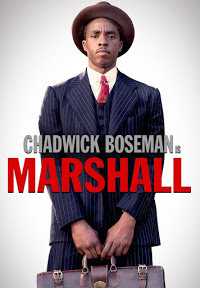
September 4, 2020
Fake News: "To Die For"
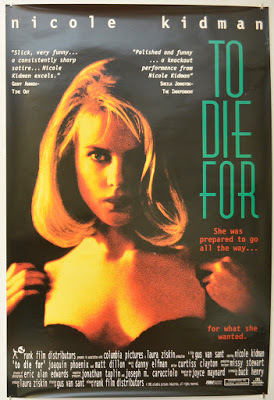
To Die For was released back in 1995, so why does it seem so up-to-the-minute? Partly this is due to the sad fact that it was consistently mentioned in obituaries for the late Buck Henry, who left us (alas!) on January 8 of this year, at the age of 89. Henry wrote the tart and brilliant screenplay, based on a novel by Joyce Maynard (who as a college co-ed had a secret sexual relationship with the fifty-three-year-old J.D. Salinger -- a spicy tidbit that has nothing to do with this story). Maynard's inspiration for her novel was an actual New Hampshire criminal case involving Pamela Smart, a cute young thing who seduced a naive high school kid, then persuaded him to murder her husband.
In the film, the role of the adorable but conniving Suzanne Stone is played by a bubbly and blonde Nicole Kidman, in what I consider one of her very best roles. What resonates with me in the current day and age is Suzanne's ambition. Although not especially talented, she will do whatever it takes (including murder) to succeed as a television personality. Her mantra, repeated several times in the film, makes it quite clear what she wants out of life: "You're not anybody in America unless you're on TV. On TV is where we learn about who we really are. Because what's the point of doing anything worthwhile if nobody's watching? And if people are watching, it makes you a better person."
That's why, after nabbing a Girl Friday job at a tiny local cable-access station, Suzanne sets off on a campaign to turn herself into an on-camera personality. Like some of today's TV superstars I could mention, she seems far less interested in delivering the news than in burnishing her own reputation as a sexy commentator on public affairs. Her obsessive quest for celebrity of course shakes up her marriage to an adoring local guy (Matt Dillon) who simply wants a loving wife and a baby.
The cast is filled with effective supporting players, including Dan Hedaya as Suzanne's Italian father-in-law, Wayne Knight as her bemused boss, and Buck Henry himself (complete with dorky mustache and bowtie) as a prim high school teacher. Illeana Douglas has a vivid role as Dillon's cynical ice-skating sister, someone smart enough to mistrust Suzanne from the start. Among the trio of high school misfits Suzanne pulls into her lethal orbit are two future Oscar winners, Casey Affleck as the spaced-out Russell and Joaquin Phoenix as the love-besotted James. The third partner-in-crime, a self-loathing young girl played by Alison Folland, notes at the end of the film that -- thanks to her small part in the murder plot and the subsequent media attention surrounding it -- she herself has enjoyed some of the fame that Suzanne had promised would come from appearing on-screen in the living-rooms of a nation. Such irony! Folland's Lydia fully intends to live out the fact that "if people are watching, it makes you a better person."
As we've all seen recently, there's no end to the good that can come to you if you make a splash on television. It's not fake news to say that TV celebrity can lead to much bigger things in much wider circles of power. "On TV," as Suzanne has insisted, "is where we learn about who we really are." It's also where a nation discovers what kind of person tickles our collective fancy. In an election year, it's especially worth pondering what makes someone telegenic, and what gives him or her a public reputation to die for.
September 1, 2020
Zack and Miri and Rose and Charlie: Near-Fatal Attraction
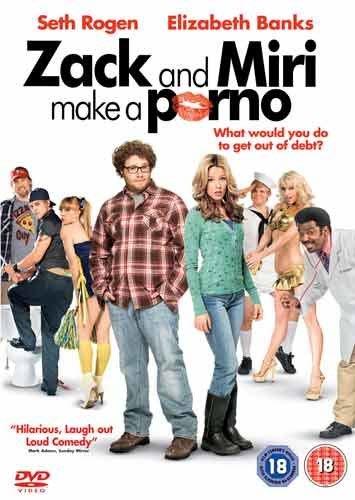
The meet-cute is a Hollywood staple: it is, of course, the contrivance that brings together two highly ill-assorted people (let’s say a man and a woman) who bicker and spar, but then—by the last reel—discover they’ve fallen in love. This trope is the mainstay of too many romantic comedies to count, everything from 1938’s Bringing Up Baby to You’ve Got Mail sixty years later. I’m thinking about two movies that don’t actually start with a first meeting. The couples in question have known each other long before the action begins. But they’re far from an obvious pairing . . . until lightning strikes.
And yet, vive la différence! There’s a whole new world between the coupling of Rosie and Charlie in The African Queen (1951) and the two Millennials at the center of the 2008 romp, Zack and Miri Make a Porno. Zack (Seth Rogen) and Miri (Elizabeth Banks) are roommates, trying to make ends meet in a grotty apartment while working bottom-of-the-barrel jobs at a local strip mall. They’ve had their share of intimate encounters (as when accidentally barging in on one another in the bathroom). And neither is short on sexual experience Still, these two losers who’ve been buddies since grammar school never stop to consider each other as potential romantic conquests.
Life changes dramatically when a viral selfie (long story!) inspires them to try for the big bucks by casting themselves in a porn flick. This being a Kevin Smith movie, the language throughout is raunchy in the extreme, and some of the film’s situations skirt – or elude altogether -- the boundaries of good taste. Hilariously, of course. But at base what we have is a love story, between two nice young people who will, we’re quite sure, live happily ever after. With, as we learn at the fadeout, a surefire new business plan to keep two bodies and two souls together.
The African Queen is set not in a Pittsburgh suburb but in darkest Africa, circa 1914, where the genteel Rose Sayer (Katharine Hepburn) and her brother Samuel (Robert Morley) serve the local populace as Methodist missionaries. This is German colonial territory: the outbreak of World War I brings a German attack that destroys their modest village and ultimately kills Samuel. Rose’s only way out is aboard a rickety little steam launch captained by the rough-and-ready Canadian mechanic Charlie Allnut (Humphrey Bogart, in his only Oscar-winning role).
As the prim-and-proper Miss Sayer and the gin-swilling Mr. Allnut travel downstream in close quarters, they seem far from a perfect match. But once she’s discovered the charms of bathing in the river in her scanties, Rose reveals a whole different side to her personality: one that’s courageous and ripe for adventure. Soon the unlikely duo is braving white-water rapids, en route to the lake where they’ll make a quixotic stand against a German military vessel. It’s life or death, but Rose is blooming. And Charlie fully appreciates her grit.
This film was shot largely on location by the always-colorful John Huston. The African experience was so grueling, including serious bouts of illness for cast and crew, that Hepburn later published a lively account. And young Peter Viertel, who co-scripted the screen adaptation, penned a scathing portrait of Huston and his maniacal insistence on shooting an elephant before filmmaking could commence. Viertel’s White Hunter, Black Heart itself later became a mediocre 1990 film directed by and starring Clint Eastwood in the Huston role.
As for Charlie and Rose, here’s how the original novel ends: "Whether or not they lived happily ever after is not easily decided."
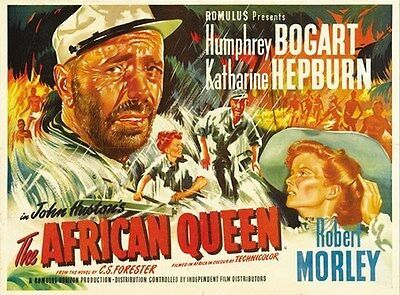
August 28, 2020
Donnie Brasco: Why I Can’t Fuhgeddaboudit

It’s not 100% correct to say that Donnie Brasco, the 1997 crime thriller I saw last night, haunts my dreams. Still, I woke up this morning realizing that the central strand of the film, which stars Al Pacino and Johnny Depp, had woven its way into my subconscious. I’ve long since come to recognize my basic need to keep writing, no matter what: hence the longevity of this nine-year-old blog. And, especially of late, my dreams have been full of moments in which I’m doing archival research, wrestling with words, and otherwise making like a writer.
Donnie Brasco, though, is not about writing at all, except perhaps when we see cryptic messages being tapped out on an old-fashioned typewriter keyboard. Instead, it’s about a murderous Mafia gang, based on the real-life Bonnano crime family that helped to rule New York’s mean streets in the 1970s. Donnie Brasco was real too, sort of. His was the actual nom de guerre of an undercover FBI agent whose mandate was to infiltrate the gang and take it down. As played by Depp, he’s a solemn young fellow who scowls often and has a wicked right hook. He knows the local goombah lingo like a pro, and he seems capable of intense personal loyalty. All of which helps him to connect with Lefty (Al Pacino), an ageing hitman who’s chafing under the realization that he’ll never be “upped” to a position of power. Lefty takes Donnie, posing as a jewel thief, into his confidence and introduces him to the big boys. Soon Donnie is being pressured on all sides: by the organization, by his FBI bosses, by the suburban wife and kids he keeps carefully hidden. But his personal affection for Lefty and for the thrills of the loud, crude lifestyle that Lefty represents exert a powerful tug.
So how does this fit into my nocturnal cogitations? Well, in my dream I am (much as I am in real life) a biographer, researching a behind-the-scenes Hollywood personality. I know this guy slightly, and so I hang around, trying to pick up tidbits that will someday be of use. I also take advantage of a passing acquaintance with his ex-wife, all in the service of trying to probe his secrets. Like, for instance, the fact that at a low point in his life he survived by selling genocide insurance (say what?) to elderly Jews fearful of another Holocaust. As a would-be biographer of this man, I am his secret shadow, much as Donnie creates and sustains a deep friendship with Lefty that justifies his covert professional role, but also at times transcends it.
For the truth of the matter is that Donnie not only likes Lefty; he likes being a Wise Guy. And the Wise Guy persona – pugnacious, brutal, quick on the trigger – is one he comes to adopt more and more in his personal life. So, ultimately, something has to give.
We’ve all seen our share of Mafia movies: it sometimes seems that every major filmmaker out there tries to put his stamp on the genre. This one, surprisingly, is the work of a British director, Mike Newell, who’s best known for delightful froth like Four Weddings and a Funeral. He’s done nicely here: Donnie Brasco is a darkly elegant piece of work. But the heart of the film is doubtless the interplay between Depp and Pacino. Depp’s usual tightly clenched wariness is effective, but it may be Pacino I’ll remember most fondly. Once he was the up-and-coming junior godfather Michael Corleone; now he’s world-weary and unforgettable. Fuhgeddaboudit!
August 25, 2020
Boys on Top: “Top Gun” Revisited
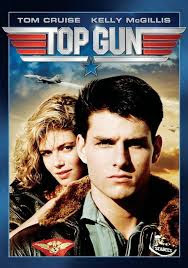 A year from now (at least we can hope!), Top Gun: Maverick will come roaring into movie theatres across the nation. That’s right: we’ll see Tom Cruise as Maverick and Val Kilmer as his frenemy Iceman return three decades later as U.S. Navy flyboys who still feel a need for speed. This news sent me back to the 1986 original, which sealed Tom Cruise’s legacy as the action hero with the most agreeably cocky grin in Hollywood.
A year from now (at least we can hope!), Top Gun: Maverick will come roaring into movie theatres across the nation. That’s right: we’ll see Tom Cruise as Maverick and Val Kilmer as his frenemy Iceman return three decades later as U.S. Navy flyboys who still feel a need for speed. This news sent me back to the 1986 original, which sealed Tom Cruise’s legacy as the action hero with the most agreeably cocky grin in Hollywood. Top Gun was, I’ve learned, the Navy’s best recruiting tool of all time. After seeing it, young men flocked to recruitment offices, eager to sign up to wear pristine white uniforms and soar like eagles in defense of their country. (Who needs video games when you can do the real thing?) It’s hardly clear whether a next-gen Top Gun will have the same appeal, in an era where wars seem to be getting hotter all the time, but the romantic spirit of the original is what has stayed with me. That and the fact that Top Gun is essentially an ode to masculinity. The message: boys just gotta be boys, and ain’t it grand?
What makes Top Gun such a testosterone flick? Well, it’s crammed full of young guys with cool codenames like Cougar and Wolfman and Merlin. They share a blood-brother camaraderie, as well as a boyish sense of adventure that would be right at home on a Cub Scout sleepaway. A self-confident swagger is something they prize, even if it’s softened by the secret sorrows they do their best to conceal. (Maverick is dealing with a mysteriously lost father, and his evolving relationship with flight instructor “Viper” – played by Tom Skerritt – has all the complexity of a father/son bond.) These men are easy on the eyes too: as they shed their shirts to play beach volleyball, the camera shamelessly ogles their glistening pecs.
Are there women in this man’s world? Of course, although the feminine gets short shrift here. Cruise’s leading lady, Kelly McGillis, is undeniably gorgeous, and yet part of her charm in this film is that she can hold her own in a man’s world. Not only is she beautiful and brainy and good at a quip: she’s an aviation expert who lives to talk knowledgeably about fighter jets. She looks fully comfortable astride a motorcycle, and even her nickname – “Charlie” – is tomboyish. The film’s second important female character, played by a very youthful Meg Ryan, is more traditionally feminine: she’s the cutie-pie wife of Maverick’s best pal and mother of a young son. Still, she comes across as a male fantasy figure when she shouts to her spouse across a crowded barroom, “You big stud . . . take me to bed or lose me forever.” Later in the film, while dealing with her own fresh bereavement, she takes it upon herself to console Maverick. Yes, she’s lost her husband and the father of her child, but in this movie he’s the one who’s really suffering after his buddy bites the big one on his watch.
The death of Goose is a sad moment, needless to say, but it only serves to shore up the idea that pain must be accepted as one component of pride and accomplishment. There’s no room in a man’s world for sorrow to serve as a stumbling block. Instead, like the knights of old, Maverick and his buddies must bury their grief and move on. Because, of course, a boy-man’s gotta do what a boy-man’s gotta do. It will be interesting to see if the near-geriatric 2021 Maverick still follows that code.
August 21, 2020
Talking ‘Bout “The Conversation”
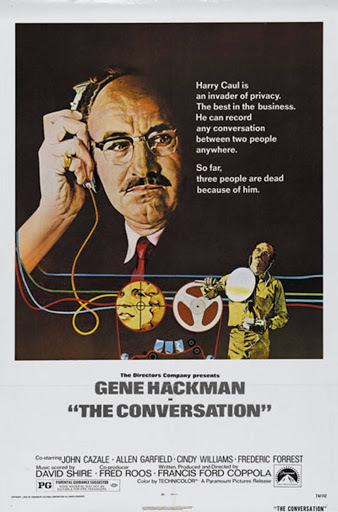 In early 1974, between the release of The Godfather and The Godfather, Part II, Francis Ford Coppola wrote and directed a small film that had big implications for life in these United States. The Conversation—which hinges on the covert taping of private speech—has a clear, though subtle, tie-in to the presidency of Richard Nixon, who would resign from office in August 1974, partly due to the secret tape recordings he made in the Oval Office. The events of Watergate, of course, came to a head 46 years ago, but The Conversation still feels fresh, even if the technology used within the story now seems dated. In focusing on secret surveillance and the bugging of private conversations by electronic means, the film suggests how vulnerable we are to outside tinkering with our lives. At a time when we’re all watching out for identity theft and bemoaning the way social media has robbed us of our privacy, The Conversation has a lot to say. It’s a paranoia classic wholly fit for our current age of anxiety.
In early 1974, between the release of The Godfather and The Godfather, Part II, Francis Ford Coppola wrote and directed a small film that had big implications for life in these United States. The Conversation—which hinges on the covert taping of private speech—has a clear, though subtle, tie-in to the presidency of Richard Nixon, who would resign from office in August 1974, partly due to the secret tape recordings he made in the Oval Office. The events of Watergate, of course, came to a head 46 years ago, but The Conversation still feels fresh, even if the technology used within the story now seems dated. In focusing on secret surveillance and the bugging of private conversations by electronic means, the film suggests how vulnerable we are to outside tinkering with our lives. At a time when we’re all watching out for identity theft and bemoaning the way social media has robbed us of our privacy, The Conversation has a lot to say. It’s a paranoia classic wholly fit for our current age of anxiety. Gene Hackman as Harry Caul is the film’s ostensible everyman hero. But it’s not that the good guys and bad guys are clearly distinguished. That’s something else that seems all too modern: the ambiguity of the moral choices made in the course of the action. Harry is, by trade, a professional security guy, which means he’s an expert wiretapper and someone who knows how to delicately separate incriminating speech from background noise. Unfortunately for him, his one stab at taking a moral stand basically ends up making things worse. That nice young couple in the park: what are they really up to? And how can he, basically a loner who doesn’t have much use for other people, square his job description with the prickings of his conscience?
I’ve heard that Coppola was inspired by Antonioni’s Blow-Up, in which a British photographer (David Hemmings) finds what he thinks might be evidence of a crime hidden within a casual snapshot he took in a local park. Coppola’s film is less exotic and less existential than Blow-Up (yes, a mime is briefly present in his park too, but that mime is not playing tennis with an imaginary ball). Yet, for all of that, it’s fascinating how in these films two masters of cinema both look at the tools of their trade—whether photography or sound recording—afresh, recognizing that these have the potential to lead less to truth than to confusion and even danger.
Along with Hackman (coming off his Oscar for The French Connection), Coppola has cast such pros as Teri Garr (just prior to her breakout role in Young Frankenstein), John Cazale, Frederick Forrest, Cindy Williams, and (in a small, sinister part) the young Harrison Ford. I have to particularly mention the fine character actor Allen Garfield, who plays a hustling surveillance pro: this past April, he died of COVID-19 at the age of 80. And yes! that’s an uncredited Robert Duvall, stepping away from his Tom Hagen identity in the Godfather films, in the shadowy but essential role of a business tycoon known only as “The Director.”
Though The Conversation never attracted Godfather-sized box office, it was not overlooked by the members of the Academy. It was nominated for three Oscars: for best picture, best original screenplay, and (appropriately) best sound design. Alas, it received no statuettes. The big winner that year: Coppola’s other project, The Godfather, Part II. Amazing that two of the five best picture nominees for 1975 were directed by the same not-yet-forty-year-old man.
Beverly in Movieland
- Beverly Gray's profile
- 10 followers


